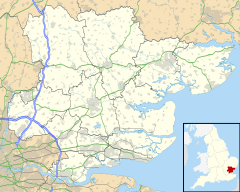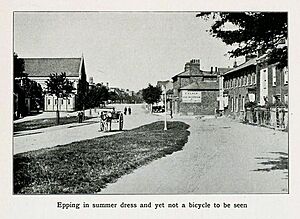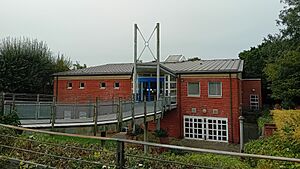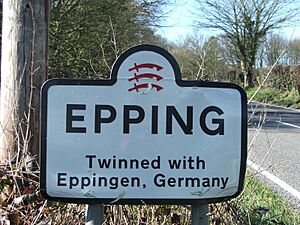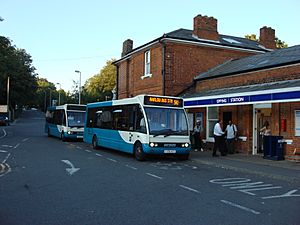Epping, Essex facts for kids
Quick facts for kids Epping |
|
|---|---|
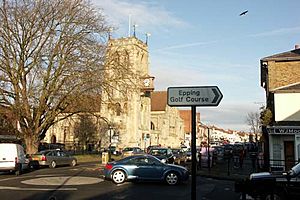 High Street, and church of St John the Baptist |
|
| Area | 7.73 km2 (2.98 sq mi) |
| Population | 11,047 (civil parish, 2001) 11,461 (civil parish 2011) |
| • Density | 1,429/km2 (3,700/sq mi) |
| OS grid reference | TL455025 |
| • London | 17 mi (27 km) SW |
| Civil parish |
|
| District | |
| Shire county | |
| Region | |
| Country | England |
| Sovereign state | United Kingdom |
| Post town | EPPING |
| Postcode district | CM16 |
| Dialling code | 01992 |
| Police | Essex |
| Fire | Essex |
| Ambulance | East of England |
| EU Parliament | East of England |
| UK Parliament |
|
Epping is a busy market town and civil parish in Essex, England. It's located about 17 miles (27 km) northeast of central London. Epping is surrounded by the beautiful Epping Forest and sits on a ridge of land between two river valleys, the River Roding and River Lea.
This town is the last stop on the London Underground's Central line. Epping has many old and important buildings, some of which are hundreds of years old. The town's weekly market, which started way back in 1253, is still held every Monday. In 2011, about 11,461 people lived in Epping. Since 1981, Epping has been twinned with Eppingen, a town in Germany.
Contents
Epping's Past: A Look at History
Early Days: From "Epinga" to Epping Heath
The name "Epinga" first appeared in the Domesday Book in 1086. This was a small group of farms and a chapel near the forest. This early settlement is now known as Epping Upland. We don't know exactly when the Epping we see today was first settled.
By the mid-1100s, a new settlement called Epping Heath began to grow. This happened south of Epping Upland as people cleared parts of the forest to grow crops.
The Market and Growth of Epping Street
In 1253, King Henry III gave Epping Heath the right to hold a weekly market. This was a big deal! It helped the town become a busy trading center. The market is still going strong today. For a long time, farmers even sold cattle right on the High Street, until 1961.
Epping Heath grew from a small village into a town along a main road. By the early 1800s, buildings lined what is now High Street and Hemnall Street. Hemnall Street used to be in a different parish until 1894.
Coaching Inns and the Railway Age
In the past, Epping was a very important stop for travelers. Up to 25 stagecoaches and mailcoaches passed through the town every day. They were traveling from London to places like Norwich and Cambridge. In the early 1800s, there were 26 coaching inns (places for travelers to stay) along the High Street. Today, only two remain as public houses: The George and Dragon and The Black Lion.
When railways became popular, fewer coaches traveled through Epping, and the town became quieter. However, Epping bounced back after a railway line from Loughton was extended to the town in 1865. The arrival of cars also helped the town grow again.
Historic Buildings and Churches
Many of Epping's buildings are very old, mostly from the 1700s. They line both sides of the High Street. Some of the oldest buildings are from the 1600s and early 1700s.
The first church in the area, All Saints' in Epping Upland, was mentioned in 1177. In 1833, the chapel of St John the Baptist on the High Road was rebuilt in a style called Gothic Revival. This church became Epping's main parish church in 1888 and was rebuilt again. A large tower was added to it in 1909.
Epping was also known for its special Epping sausage and, in the 1700s and 1800s, for Epping butter.
How Epping is Governed
Epping has three levels of local government that help run the town:
- Epping Town Council: This is the local council for the town itself. Their main office is at Epping Hall.
- Epping Forest District Council: This council covers the wider Epping Forest area. Their offices are also in Epping, on High Street.
- Essex County Council: This council looks after services for the whole county of Essex.
Local Representatives
Epping is divided into two areas for the district council elections: Epping Hemnall and Epping Lindsey and Thornwood. Each of these areas elects three councillors to represent the local people.
Changes in Local Government
Epping used to be an "ancient parish." In 1894, when new local councils were created, Epping got a parish council. Soon after, it was decided that Epping should become an "urban district," which is a type of local government for towns. On April 1, 1896, the parish was split. The more rural part became Epping Upland, and the town part became the Epping Urban District.
The Epping Urban District was ended in 1974. A new parish was created for the area, and its council became the Epping Town Council we have today.
Parliamentary Representation
Epping is part of the Epping Forest area for the UK Parliament. This area is represented by a Member of Parliament (MP). From 1924 to 1945, the famous Winston Churchill was the MP for the Epping area. He was Prime Minister during World War II.
Epping's Location and Surroundings
Epping is about 17 miles (27 km) northeast of central London. It's located near the northern end of Epping Forest. The town sits on a raised area of land between the River Roding and River Lea valleys.
The town is close to major roads. The M25 motorway (London's orbital motorway) passes to the south of Epping. The M11 motorway is to the east.
Community Life in Epping
Most people in Epping live in the main built-up area around the High Street and Station Road. About a thousand people live in the village of Coopersale, which is part of Epping parish but separated by forest. Smaller groups of homes are found in the hamlets of Coopersale Street and Fiddlers Hamlet.
The weekly Epping market on Mondays brings shoppers from nearby villages and towns. A noticeable building in Epping is the District Council's office, which has a clock tower. This tower helps balance the look of the High Street with the old Gothic Revival water tower and St John's Church tower. The center of Epping, especially around the High Street, is a special "conservation area" to protect its historic feel.
Getting Around Epping
Epping has good connections for travel by train, bus, and road. There are also many walking trails.
Train and Tube Connections
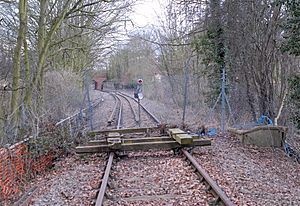
Epping tube station is the last stop on the London Underground's Central line. This station is in London fare zone 6. You can use an Oyster card or contactless payment here. There is a car park at the station. The Central line connects Epping directly to East London, Stratford, the City of London, Oxford Street, and West London.
Until 1994, the Central line went further north from Epping to places like North Weald and Ongar. Much of that old line is now a special heritage railway called the Epping Ongar Railway. This heritage railway doesn't stop at Epping tube station, but sometimes a special old London bus connects the two.
The closest main train stations are at Roydon, Harlow, and Waltham Cross. Trains from these stations go to London Liverpool Street, Stratford, Hertford, Cambridge, and Stansted Airport.
Bus Services
Epping is served by several bus routes that connect it to surrounding towns and villages.
| Route Number | Terminals | Via | Operator | Notes | |
| 13/13A/13C |
Waltham Cross | Epping | Waltham Abbey, Upshire | Central Connect | Mon-Sat |
| 18/18C |
Loughton tube station | North Weald | Debden tube station, Abridge, Theydon Bois, Epping | Central Connect | Mon-Sat |
| 19 | Harlow | Chelmsford | Thornwood, Epping, North Weald, Ongar | First Essex | Mon-Fri |
| 20 |
Ongar | Harlow | North Weald, Epping, Thornwood Common |
Central Connect | Mon-Sun |
| 21 |
Epping | Harlow | Thornwood Common, Potter Street, Brays Grove | Central Connect | Mon-Sat |
| 22 |
Epping | Harlow | North Weald, Potter Street | Central Connect | Mon-Sun |
| 31 |
Coopersale | Harlow | Epping, Epping Green, Roydon | Central Connect | Mon-Sat |
| 620 |
Abridge | Ingatestone | North Weald, Ongar | First Essex | Mon -Fri |
Road Network
Epping High Street is part of the B1393 road. This road runs north-south through the town. To the north, it connects to the M11 motorway for Cambridge, Stansted Airport, and London. To the south, it connects to the A104 and A121 roads, which lead to other towns and the M25 London Orbital.
Other roads like the B181 and B182 also pass through or near Epping. These roads are looked after by Essex Highways. The M11 and M25 motorways bypass Epping, meaning they go around the town.
Walking and Cycling Paths
Epping Forest offers lots of places to walk and explore. The City of London Corporation, which manages the forest, has created many marked walking routes. There are also marked footpaths connecting Epping to nearby villages like Coopersale and Theydon Bois.
Epping and the surrounding forest are popular with cyclists. While there aren't specific cycle lanes on the B1393, a cycle lane runs alongside the A104 road.
Learning in Epping: Schools and Education
Epping has several schools for different age groups:
- Epping St John's School: This is the main secondary school in Epping. It's a Church of England school. Students here are very active in fundraising for charities.
- The Tower School: This is a special educational needs school.
- Coopersale Hall School: A prep school for younger children.
- Ivy Chimneys Primary School: A primary school located in Ivy Chimneys.
- Epping Primary School
- Coopersale and Theydon Garnon C.E. (Vol.Cont.) Primary School: A primary school located in Coopersale village.
Media and Entertainment
Because Epping is close to London, people usually get their TV signals from the Crystal Palace transmitter. This means they receive BBC London and ITV London channels. However, some people can also get signals from the Sandy Heath transmitter, which broadcasts BBC East and ITV Anglia.
For radio, you can listen to BBC Essex (95.3 FM), Heart Essex (101.7 FM), and Forest Gold Radio (99.3 FM), which is a local community radio station. The local newspaper for the town is called the Epping Forest Guardian.
Sports in Epping
Epping has a history with football. Epping Town used to play in a league until 1985. Currently, Epping FC plays in the Essex Olympian Football League. Both teams have played at a ground called Stonards Hill.
There are also two cricket clubs in the south of the town: Epping Cricket Club and Epping Foresters Cricket Club. Epping Foresters' ground is actually built on top of the Bell Common Tunnel of the M25 motorway!
Famous People from Epping
Many well-known people have connections to Epping:
- Jill Barklem, writer and illustrator
- Nick Berry, actor
- David Byron, former lead singer of the rock band Uriah Heep
- Winston Churchill, a Member of Parliament for the Epping area from 1924 to 1945, including when he was Prime Minister during World War II
- Dodie Clark, singer and YouTuber
- Crass, a band
- Sidney Godley, the first private soldier to receive the Victoria Cross during World War I
- Dave Gahan, singer and frontman of Depeche Mode
- Philip Hammond, a former important government minister (Chancellor of the Exchequer)
- David Halls, television entertainer and chef
- Glenn Hoddle, a former professional football player and manager
- Griff Rhys Jones, TV presenter and comedian
- Jason Merrells, actor
- Julian Mitchell, screenwriter and novelist
- Dennis Rofe, a former professional footballer
- Ben Shephard, television presenter
- Lisa Snowdon, model
- Rod Stewart, singer
- Jessie Wallace, actress
- Bradley Walsh, actor and television presenter
- Adrian Whitbread, football coach
- Gary Wraight, footballer
See also
 In Spanish: Epping (Essex) para niños
In Spanish: Epping (Essex) para niños


